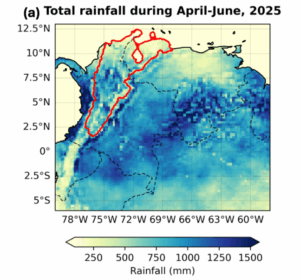In late June 2025, several days of heavy rainfall swept across Colombia and Venezuela, causing widespread flooding, overflowing rivers, and numerous landslides.
One of the deadliest events took place in Colombia, where the June rain fell on saturated soils. Leading to a massive landslide that hit Granizal, near Medellín, claiming 27 lives (Alcaldía Bello, 7 July, 2025). In Venezuela, the states of Mérida, Trujillo, and Táchira were among the worst impacted regions. Sustained rainfall in these parts led to the rivers Motatán and Burate to overflow. Damaging infrastructure, flooding homes, and sweeping away buildings and vehicles (The Watchers, 25 June, 2025).

To analyse whether and to what extent human-caused climate change altered the likelihood and intensity of the heavy rainfall that led to the floods. Causing the damages and resulting in casualties, scientists from Colombia, the Netherlands, Sweden, the UK and the US used published, peer-reviewed methods to perform an event attribution study.
The annual rainfall patterns across Colombia and Venezuela are very different and modulated by complex topography and large scale climate variability. Furthermore, Colombia, in particular the region around Medellín, has experienced a very wet April. Followed by a more average May and again a very wet June, which meant the rain at the end of June fell on saturated ground, and on rivers that already had very high water levels.
In Venezuela, the flooding was more directly connected to the heavy rain at the end of June. To account for these complexities we study two events:
(1) the total rainfall from April to June over the Magdalena river catchment in Colombia (a region comprising the Colombian Andes) and the Falcón and Maracaibo basins in Venezuela (Fig. 1a); and
(2) the heavy rainfall over 5 days, measured as the Rx5days, the 5 wettest days per year. In the states of Barinas, Tachira, Trujillo, Mérida, Portuguesa and Apure, a region comprising the Venezuelan Llanos (Fig. 1b).

Main Findings
- Landslides are common in Colombia and Venezuela during the rainy season due to steep slopes and loose soils. The rapid growth of population and informal settlements in areas prone to landslides, particularly in Colombia, puts people and infrastructure at risk. These informal communities are growing as a result of rapid urbanization as more people move to cities for economic prospects. And in Colombia many of those people are also displaced as a result of violence and conflict.
- Deforestation and the conversion of the Páramos to agricultural land, mining concessions, and overgrazing have reduced the natural ecosystems. The ability to regulate rainfall-induced floods and increased susceptibility to landslides.
- People facing internal displacement, economic instability, or conflict face double the risk. When combined with recurring climate hazards, this erodes their resilience over time.
- Based on gridded data products, we find no extreme seasonal rainfall over the Colombian Andes from April to June (AMJ).
- The Rx5day event over the Venezuelan Llanos was also not meteorologically extreme, with a return period of about three years.
- When we compare the AMJ event today with a climate 1.3°C cooler, we see rainfall has become less likely.
- The likelihood and intensity of seasonal rainfall decreased by about 12%, though the uncertainty around this is large.
- For the Rx5day event in the Venezuelan Llanos, we also see a drying trend in heavy precipitation intensity, dropping by 9%.
- However, one of three datasets shows an increase, highlighting how variable these results can be.
- To measure the role of human-driven climate change, we analysed climate model data for the historical period.
- The models disagree on the AMJ event for the Colombian Andes: some simulate more rain, others less.
- Still, most show a decreasing trend in seasonal rainfall for this region.
- For the Rx5day in the Venezuelan Llanos, the models also disagree.
- Some show a drying trend while others indicate an increase in heavy rainfall.
- These findings match published research.
- The 2021 IPCC report shows high uncertainties in observed trends for Northern South America and the Orinoco basin.
- It projects a drying of seasonal rainfall, mainly in June, July, and August.
- But it also projects heavier rainfall events like Rx5day will likely increase with future warming.
- Precipitation projections for North-Western South America, including the Colombian Andes, remain uncertain.
- The confidence in these projections is low because weather regimes react differently to climate change.
- Models still struggle to represent these differences well.
- Taken together, our results suggest wet years like this one will continue to occur in the future.
- However, the observed drying, stronger in the east, means dry years will likely become more frequent too.
- The region must prepare for more droughts and wildfires in the coming years.
- At the same time, it must also prepare for possible intense downpours.
- This is vital given the uncertainty in results and evidence of short, heavy rain even during drying trends.
- Collecting and sharing good weather data is essential to understand changing risks and build resilience.
- This is especially true for countries like Colombia and Venezuela with complex rainfall patterns.
- The large uncertainties in our results show the need for long-term, local weather observations.
- They also show the need to better represent these processes in climate models.
- This reflects a wider gap between the global north and south in weather science and monitoring.
- More investment in weather stations and climate research is needed in northern South America.
- Better data will help us understand how extreme weather is changing and how to adapt

